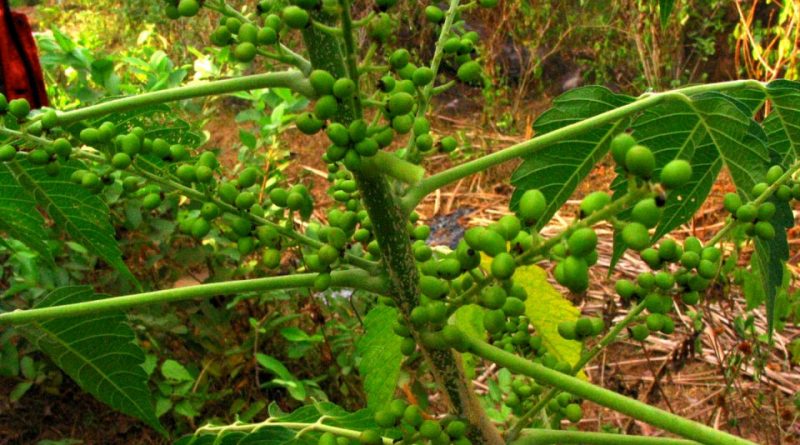Brucea javanica
Brucea javanica
Brucea javanica, also known as Macassar kernels (Brucea javanica (L.) Merr.) Is a shrubby species belonging to the Simaroubaceae family.
Systematic –
From a systematic point of view it belongs to the Eukaryota Domain, Kingdom Plantae, Magnoliophyta Division, Magnoliopsida Class, Sapindales Order, Simaroubaceae Family and therefore to the Genus Brucea and to the Species B. javanica.
The terms are synonymous:
– Ailanthus gracilis Salisb .;
– Brucea amarissima Desv. ex Gomes;
– Brucea glabrata Decne .;
– Brucea gracilis (Salisb.) DC .;
– Brucea sumatrana Roxb .;
– Brucea sumatrensis Spreng .;
– Gonus amarissimus Lour .;
– Rhus javanica L.
Etymology –
The term Brucea was given in honor of Miss E.M. Bruce who herbized in Tanzania in 1934-35.
The specific epithet javanica is in reference to the island of Java, Indonesia.
Geographical Distribution and Habitat –
Brucea javanica is a plant that grows naturally in an area that includes Sri Lanka, India, China, Indochina, Malaysia, New Guinea and Australia.
Its habitat includes open areas, secondary forests and sometimes even in sunny places on sandy and limestone dunes. In Australia it grows from sea level to 500 meters above sea level.
It grows, however, in both humid conditions and in drier areas, from sea level up to 900 meters.
Description –
Brucea javanica grows like a shrub or a small tree up to 5 meters high.
It has compound leaves (7-15 cm) ovate to ovate-lanceolate with serrated edges.
The leaves are covered with thin hairs which are more prominent in the veins and lower part of the leaves.
The flowers are small (1.5-2 mm in diameter) greenish to greenish red or purple in color and appear in panicles. On each shrub we can find both male and female separate flowers, being, therefore, both a monoecious and dioecious species. The anthers of the flowers are usually red.
It typically blooms in June and July and bears fruit in July and August.
The fruits are drupes that measure up to 0.5 cm in length. When mature they have a gray-black color that becomes wrinkled when dry. The seed is whitish yellow in color and covered by an oily membrane.
All parts of the plant are intensely bitter.
Cultivation –
Brucea javanica prefers well-drained soil and a position in full sun or partial shade. The plant grows rapidly and flowering begins early, however, the lifespan is a few years and the plants need to be regenerated from seeds at regular intervals.
Propagation can take place by seed. In a germination test the seed had a germination rate of approximately 35% within 11-27 days. The hard outer coating of the seed must be removed before sowing.
Propagation can also take place with wood cuttings in sandy soils.
Both flowering and fruiting can take place throughout the year.
Uses and Traditions –
Brucea javanica is a well-known medicinal herb in Asia; used in traditional Chinese medicine and in local medicine. All parts of the plant, but more often the seeds and roots, are used, mainly in the treatment of amoebic dysentery, diarrhea and malaria.
The fruit of Brucea javanica was written, for the first time, for its properties in medicine in the Chinese medical monograph Omissions from the Grand Materia Medica, written in 1765.
It contains quassinoid compounds called bruceolides which are anticancer and antiparasitic.
This plant is traditionally used to treat dysentery and malaria, although no clinical studies have been published confirming the effectiveness of these conditions, although in vitro studies have repeatedly shown antimalarial activity.
The plant is considered antiperiodic and febrifugal.
A form of injectable oil emulsion of the plant has been studied in controlled studies in China for the treatment of lung cancer patients combined with chemotherapy, with promising results. However, further studies are needed to confirm this use.
In addition to its use in the treatment of dysentery, malaria, etc., the plant is also used in the treatment of abdominal pain, cough, hemorrhoids, calluses, warts, ulcers and cancer.
The fruits, roots and occasionally other parts of the plant are harvested in nature for medicinal use and are also sold in local markets.
Method of Preparation –
The leaves of Brucea javanica are used externally as a poultice for various uses, such as against spleen, ringworm, bubbles and enlarged millipede stings.
The bark and roots have been used to treat toothache.
The bitter root is used against insect attacks while the seeds are used as insecticides. They contain large quantities of a remarkably bitter oil.
Guido Bissanti
Sources
– Acta Plantarum – Flora of the Italian Regions.
– Wikipedia, the free encyclopedia.
– Treben M., 2000. Health from the Lord’s Pharmacy, Tips and experiences with medicinal herbs, Ennsthaler Editore
– Pignatti S., 1982. Flora of Italy, Edagricole, Bologna.
– Conti F., Abbate G., Alessandrini A., Blasi C. (edited by), 2005. An annotated checklist of the Italian vascular flora, Palombi Editore.
Warning: Pharmaceutical applications and alimurgical uses are indicated for information purposes only, they do not in any way represent a medical prescription; therefore, no responsibility is accepted for their use for healing, aesthetic or food purposes.


